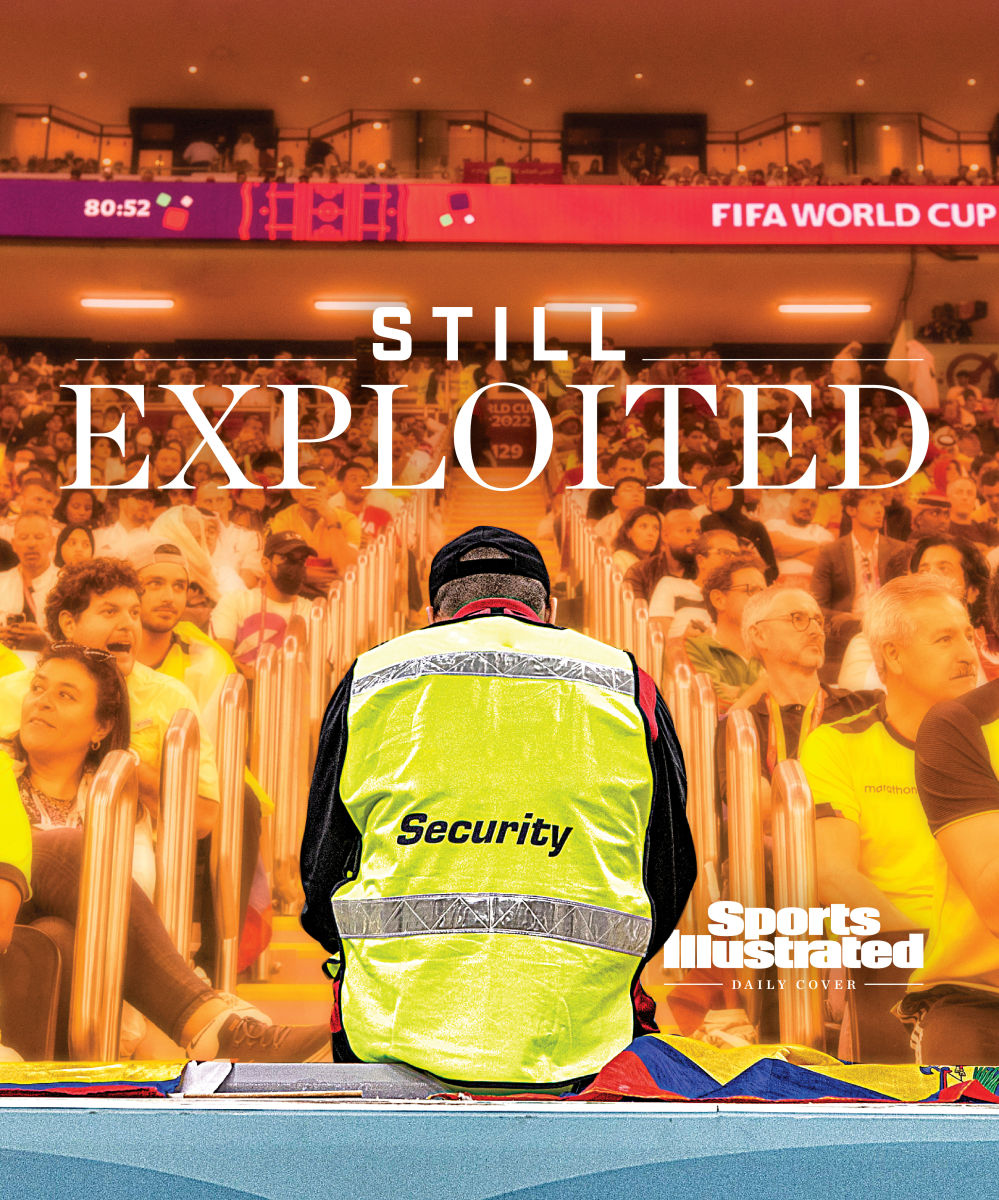SI:AM | Underdogs Are Shining at the World Cup
Good morning, I’m Dan Gartland. The World Cup drama this morning was more energizing than any cup of coffee.
In today’s SI:AM:
🇶🇦 The plight of Men’s World Cup security guards
🤑 The soulless spiral of college sports
If you're reading this on SI.com, you can sign up to get this free newsletter in your inbox each weekday at SI.com/newsletters.
New faces at the Women’s World Cup
The group stage of the Women’s World Cup is in the books, with the final two teams (Colombia and Morocco) punching their tickets to the knockout stage this morning. And when the round of 16 gets underway Saturday, there will be a bunch of unlikely participants.
Three teams—Morocco, Jamaica and South Africa—will be making their knockout-stage debuts, while traditional powers like Canada, Germany and Brazil have already crashed out of the tournament.
Germany was eliminated this morning after a 1–1 draw with South Korea. That, combined with Morocco’s 1–0 win over Colombia, knocked the Germans out of the tournament. Germany had several chances to score a winning, tournament-saving goal late in a frantic stoppage time—none better than this long-range effort from Sydney Lohmann that flew just over the crossbar. (As a brief aside, Fox play-by-play man John Strong’s commentary during the closing minutes of that game was fantastic. He did a great job of making the stakes clear and elevating the tension.)
Germany has qualified for every Women’s World Cup and had never before been eliminated before the quarterfinals. On the other hand, Morocco is making its Women’s World Cup debut and is ranked No. 72 in the world. Only Zambia (No. 77) came into the tournament with a lower ranking. The Moroccan players were elated when the whistle finally blew in the Germany–South Korea game to confirm their advancement.
Morocco is one of three African nations to advance to the knockout stage (out of the four that qualified for the tournament), along with South Africa and Nigeria. South Africa is playing in its second World Cup after losing all three matches in its debut in 2019. It advanced to the knockout stage after a dramatic upset over Italy yesterday, capped by Thembi Kgatlana’s goal in stoppage time.
Nigeria is not the same sort of underdog as the other two teams from the continent. The Super Falcons have participated in every Women’s World Cup, reaching the quarterfinals in 1999 and the round of 16 in 2019. But the team spent the lead-up to the World Cup engaged in a bitter pay dispute with the country’s governing body. The Nigerian Football Federation nearly fired coach Randy Waldrum mere days before the start of the tournament after he spoke out about money he was owed by the NFF. But the players have said they’ve tried their best to put the controversy behind them, and they’ve certainly played like a team without any distractions.
The other team making its first knockout-stage appearance is Jamaica, which was thumped in its three group-stage matches at its first World Cup in 2019 but has squeaked through to the round of 16 this time thanks to two 0–0 draws and a 1–0 win over Panama. Like Nigeria, the Jamaican team has struggled with funding. The team was actually dormant for more than three years from ’10 to ’14 because the country’s governing body refused to provide funding. While the team is back on the field again, it still lacks the financial backing of many of its competitors. According to The Athletic, during preparations for the previous World Cup, the team’s coach had to buy players raincoats at Costco with his own money, and players had to pay out of pocket to bring luggage on flights. The team resorted to fundraising campaigns to raise money for this World Cup, with Adidas and the family of Bob Marley covering the cost of its training camp, The Athletic reported.
There are plenty of other teams taking big strides forward at this World Cup, too. Colombia, playing its third World Cup, won its group. Switzerland is making just its second trip to the knockout stage. Denmark advanced out of the group for the first time since 1995. Countries around the world are beginning to take women’s soccer more seriously, and it’s made for a thrilling tournament.
The best of Sports Illustrated

- Almost a year after the World Cup in Qatar, the plight of migrant workers is not any better. In today’s Daily Cover, Greg Bishop looks at a group of security guards who say they were unjustly detained and still have not been paid for their work.
- Pat Forde argues that the current discussions around conference realignment risk ruining everything about college sports.
- Richard Johnson has all the details of the investigation into gambling by Iowa and Iowa State athletes.
- Chris Herring breaks down what we can expect from the Heat if they don’t end up trading for Damian Lillard.
- Conor Orr went to Patriots training camp and noticed that Bill Belichick never slows down—literally.
- After Tigers pitcher Eduardo Rodriguez turned down a trade to the Dodgers, Emma Baccellieri writes that his decision is a reminder that some athletes care about more than winning.
- The NFL is reportedly considering adopting the kickoff rule used in the XFL.
The top five...
… things I saw last night:
5. A classic Giancarlo Stanton opposite-field homer.
4. Mookie Betts’s moon shot that A’s left fielder Tony Kemp didn’t even bother to turn around and watch.
3. The bizarre first strikeout of Diamondbacks pitcher Slade Cecconi’s career.
2. Lionel Messi’s beautiful first goal in Inter Miami’s win over Orlando City. (He added another later in the game.)
1. This kid’s reaction to interfering with a live ball.
SIQ
On this day in 2001, the roof at Toronto’s SkyDome was closed in the middle of a game between the Blue Jays and Orioles in an attempt to offer players and fans relief from what?
- Cold temperatures
- Gale-force winds
- Wildfire smoke
- A swarm of bugs
Yesterday’s SIQ: On this day in 1938, the Dodgers and Cardinals played a doubleheader using an experimental, differently colored baseball. What color was it?
- Yellow
- Orange
- Red
- Pink
Answer: yellow. While using the balls in a game was the idea of Dodgers president Larry MacPhail, the concept for the yellow ball itself came from Frederic H. Rahr, the president of a New York color research company. Rahr had been inspired to create a higher visibility ball after Tigers catcher Mickey Cochrane was hit in the head by a pitch the year before, ending his career.
“My primary object is to give the hitter more safety and there’s no question that this will be achieved,” said Rahr in April 1938, according to the Baseball Hall of Fame. “That’s simply because the batter will be striking at a ball he can see instead of at a white object that blurs with the background. We have known for a long time that yellow was the most quickly and clearly seen of all colors, especially at high speed. That’s why traffic markers, airport markings and government specifications, where protecting human life is essential, are invariably in yellow. On the other hand, white is probably the most difficult of all colors to see in motion.”
While the yellow ball was invented around the same time as teams began playing night games, Rahr’s ball was not intended to increase visibility under the lights. In fact, it was specifically designed with day games in mind. According to a response to a reader’s letter from a 1962 issue of Sports Illustrated, Rahr’s particular shade of yellow was designed to absorb the blue from the afternoon sky, increasing its visibility.
By all accounts, the experiment was a success. Fans found the yellow ball easier to follow from the stands, and players found it easy to see from the dugout. The biggest problem was that the yellow leached onto the hands of the pitchers. The National League’s owners agreed after the season to allow teams to use the yellow ball as long as it was agreed upon before the game. But teams opted to use the ball only three times in 1939.
